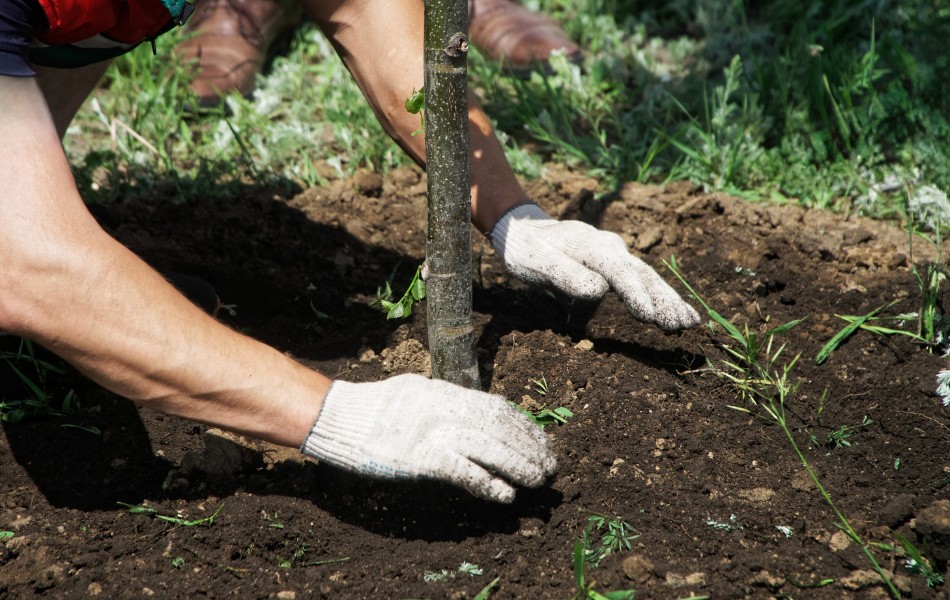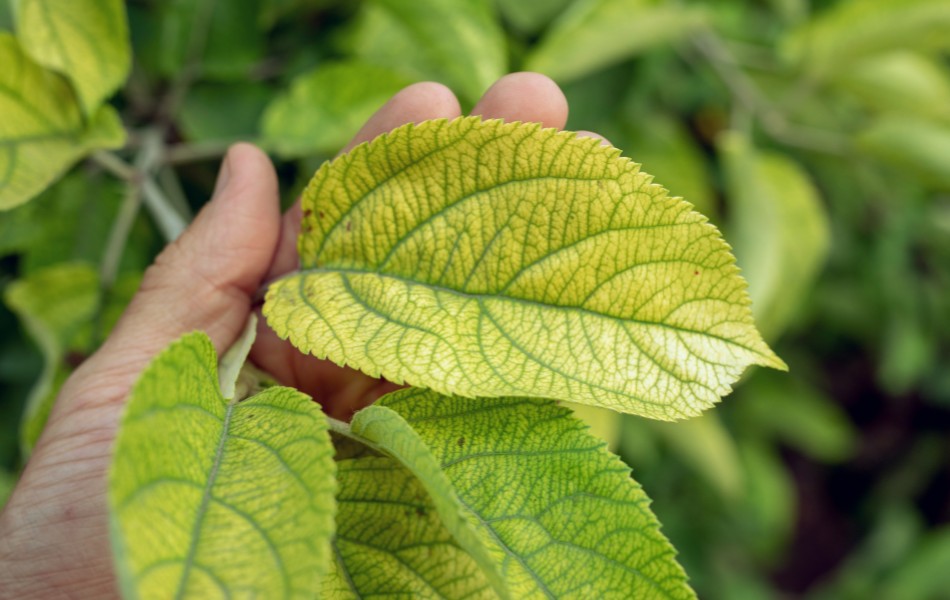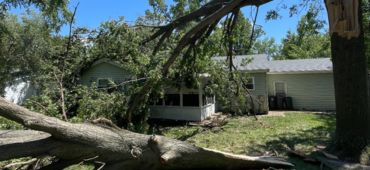The 6 Most Common Tree Pests to Look Out for in Missouri
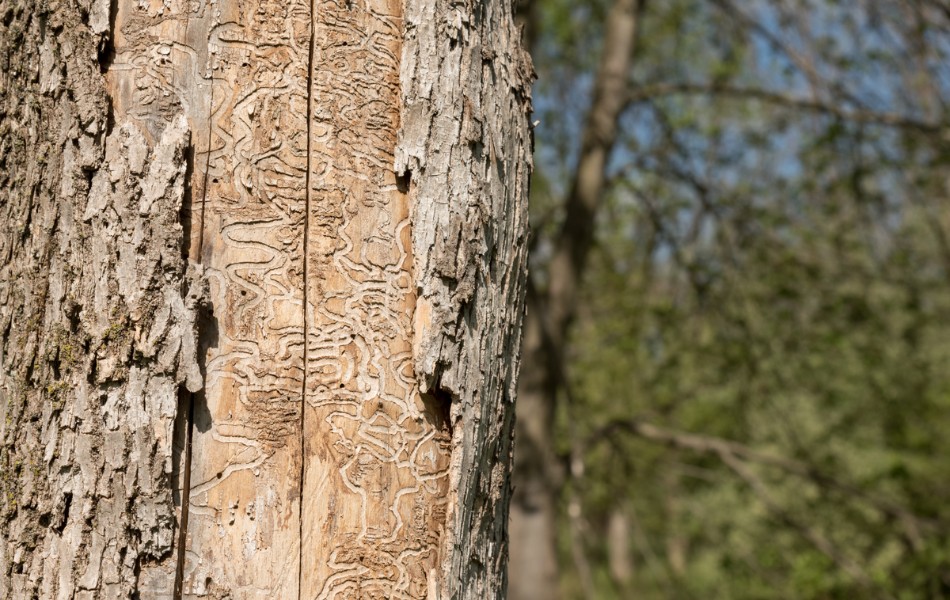
Common tree pests in Missouri can threaten your landscape. Learn how to identify infestations and keep your St. Louis trees healthy and thriving.
Trees are incredibly important for properties in St. Charles and St. Louis Counties. Not only do they create curb appeal and boost property values, but they provide much needed shade in the summer, creating comfortable outdoor spaces all while reducing energy bills.
But your Missouri trees have natural enemies – tree pests are always on the move, looking for new trees to attack and potentially destroy. And while some tree pests are a natural and native part of our ecosystem, many of the worst offenders are exotic insects that do catastrophic damage.
Here are the six most common tree pests you might encounter in St. Charles and St. Louis Counties, and how you can support and protect your trees from harm.
Key Takeaways:
- Early detection of tree pests can mean the difference between saving a valuable tree and facing expensive removal costs.
- Several invasive species, like the emerald ash borer, can kill otherwise healthy trees within 2-3 years if left untreated.
- Most tree pests target stressed or weakened trees first, making proper tree care an essential part of pest prevention.
- Professional treatment options exist for most common tree pests in Missouri, but success rates are highest when problems are caught and addressed early.
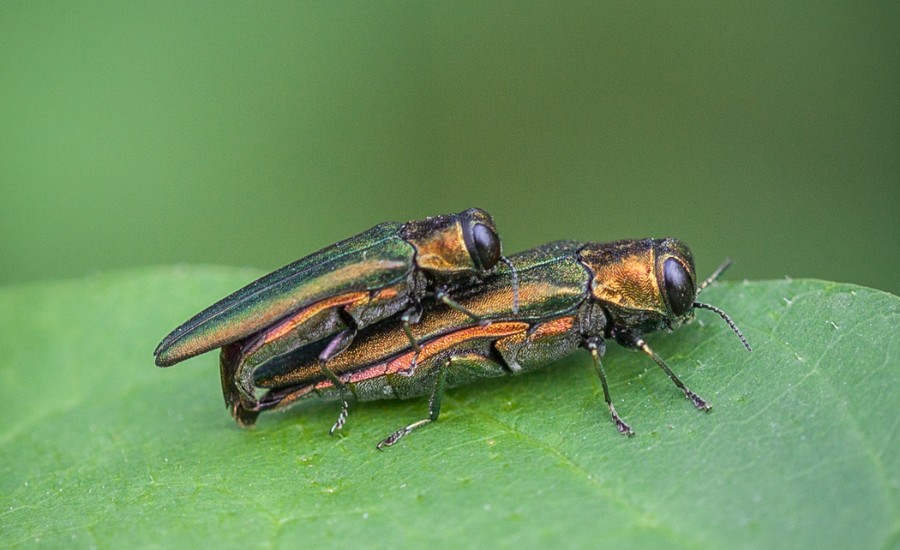
1. Emerald Ash Borer
The emerald ash borer poses the most serious threat to Missouri’s ash trees, destroying thousands of trees across the state each year. This metallic green beetle might be small (only about ½ inch long), but it can kill a healthy ash tree in just 2 to 3 years if left untreated.
The damage starts when adult beetles lay eggs in the bark crevices. After hatching, the larvae tunnel beneath the bark, creating distinctive “S” shaped galleries that cut off the tree’s ability to transport water and nutrients. By the time obvious signs appear, like crown dieback or bark splitting, treatment options become limited and expensive.
If you still have ash trees on your property, keep your eyes peeled for:
- “D” shaped exit holes in the bark about 1/8 inch wide
- Increased woodpecker activity on ash trees
- Thinning or yellowing leaves in the upper canopy
- Sprouts growing from the tree roots or trunk
- “S” shaped tunnels under loose bark
Treatment options exist if caught early enough, but they require ongoing management from Certified Arborists who understand proper timing and application methods. However, if more than 50% of the canopy shows damage, tree removal may be the only safe option to prevent hazardous conditions.
Did you know that in Gateway Arch National Park, the stunning walkways were originally lined with beautiful, mature ash trees? Once EAB was spreading, authorities knew it was only a matter of time before it would impact the trees in the park, so through a lengthy process, they replaced all of the ash trees on the park grounds before EAB could damage them.
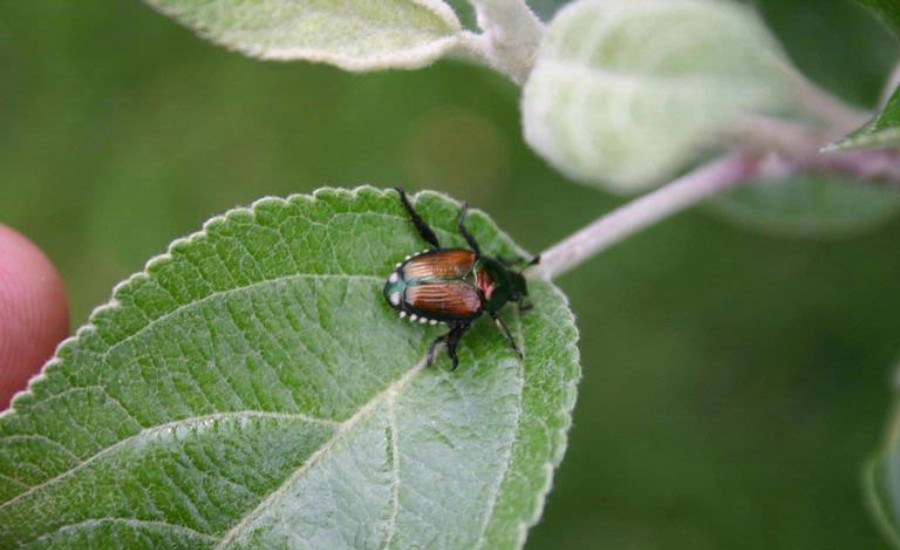
William Fountain, University of Kentucky, Bugwood.org
2. Japanese Beetles
While not as immediately lethal as emerald ash borers, Japanese beetles can severely stress trees through repeated defoliation. These copper and green beetles emerge in early summer and feed on over 300 different plant species, but they show strong preference for certain trees common in St. Louis landscapes, such as linden, birch, elm, and maple trees.
Keep your trees safe by looking out for:
- Leaves that look like lace, with only the veins remaining
- Clusters of beetles feeding together on leaves
- Brown patches appearing in the canopy
- Damaged leaves dropping prematurely in summer
While healthy trees can usually withstand a few seasons of feeding, repeated defoliation weakens trees and makes them susceptible to other problems. Professional treatment options are available and most effective when timed with beetle emergence in early summer.
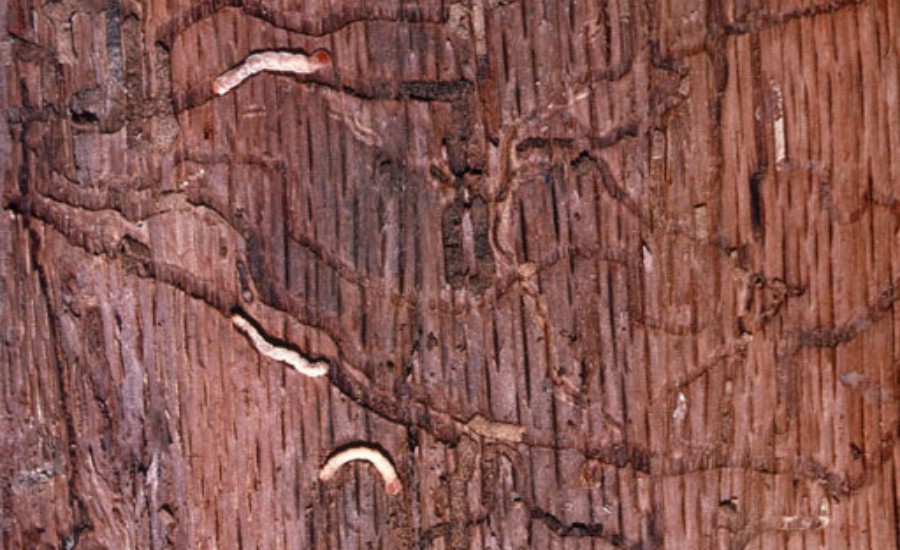
James Solomon, USDA Forest Service, Bugwood.org
3. Two-Lined Chestnut Borer
The two-lined chestnut borer has become an increasing concern for oak trees in the St. Louis area. This native beetle typically targets trees that are already stressed from drought, storm damage, or soil compaction. As our summers become hotter and drier, more oaks become vulnerable to attack.
Property owners who want their oaks to thrive for many more years should keep a lookout for:
- Wilting leaves that turn brown but stay attached to branches
- Small “D” shaped exit holes in the bark
- Dieback starting at the crown and moving downward
- Thin or sparse foliage throughout the canopy
- Dark irregular marks beneath the bark where larvae have tunneled
Once a tree is infested, the borers tunnel beneath the bark, disrupting the flow of water and nutrients. This creates a cycle where the tree becomes more stressed, attracting more borers. Treatment can be successful if caught early, especially when combined with proper watering and mulching to reduce tree stress.

William Fountain, University of Kentucky, Bugwood.org
4. Bagworms
Despite their small size, bagworms can cause significant damage to evergreen trees throughout the St. Louis region. These insects create distinctive protective bags made from silk and bits of foliage, which often go unnoticed until substantial damage has occurred. They’re shaped like Christmas ornaments, and often are mistaken as pinecones.
When bagworms feed on evergreens, especially spruce and juniper, they can completely defoliate branches. Since evergreens don’t readily produce new growth from old wood, this damage can be permanent. A single defoliation of more than 50% can kill branches or entire trees.
Young bagworms emerge in late spring, usually around late May or early June in the St. Louis area. Their bags start tiny, about the size of a pencil tip, but grow to about 2 inches long by late summer. Since these pests can quickly spread between trees, early identification and treatment is essential. A single female bagworm can lay up to 1,000 eggs, which typically hatch the following spring.
On smaller trees and plants, you can control bagworms the old-fashioned way. Simply pluck the bags by hand and destroy them. For larger trees, or extensive infestations, insecticide treatment can be effective if applied early enough in the season.
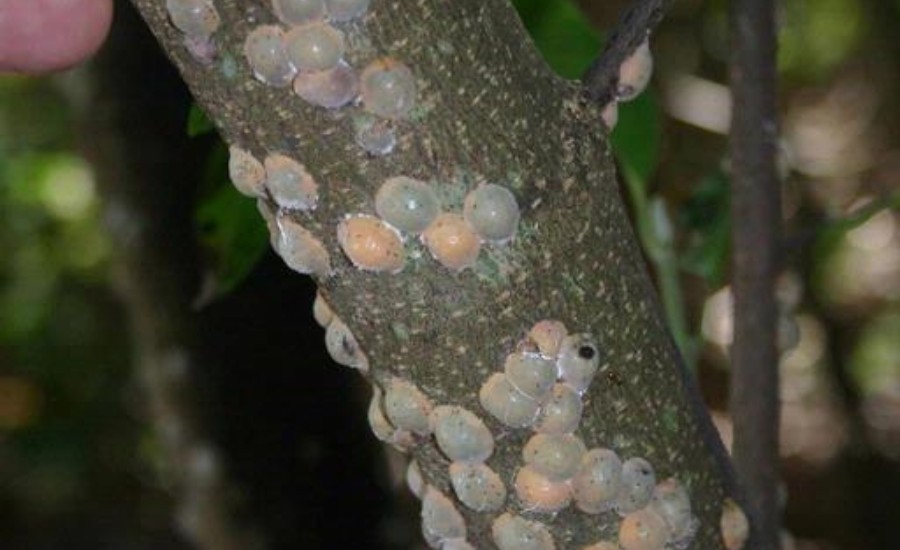
Magnolia scale | William Fountain, University of Kentucky, Bugwood.org
5. Scale Insects
Scale insects are tiny but troublesome pests that can affect nearly any tree species in the St. Louis area and beyond. These small, immobile insects attach themselves to branches, twigs, and leaves, where they feed on sap and slowly weaken trees over time. While a minor infestation might not harm an otherwise healthy tree, heavy infestations can lead to decline.
These pests often go unnoticed until damage becomes obvious. You might have a scale problem if you see your trees experiencing:
- Yellowing or wilting leaves
- Branch dieback, especially in the upper canopy
- Black sooty mold growing on branches or leaves
- Sticky residue on leaves or beneath the tree
- Small bumps on branches that can be scraped off with a fingernail
There are many types of scale insects. According to the University of Missouri, the scale insects you’re most likely to see here include, “…tulip tree scale, magnolia scale, lecanium , euonymus scale, and oak kermes.”
Treatment options vary depending on the type of scale and the time of year, but success rates are high when infestations are caught early. Many predatory insects feed on scale, helping to maintain natural control in healthy landscapes. This is why having a variety of native plants and trees in your yards is beneficial – it attracts beneficial insects and birds who help control harmful insect populations.
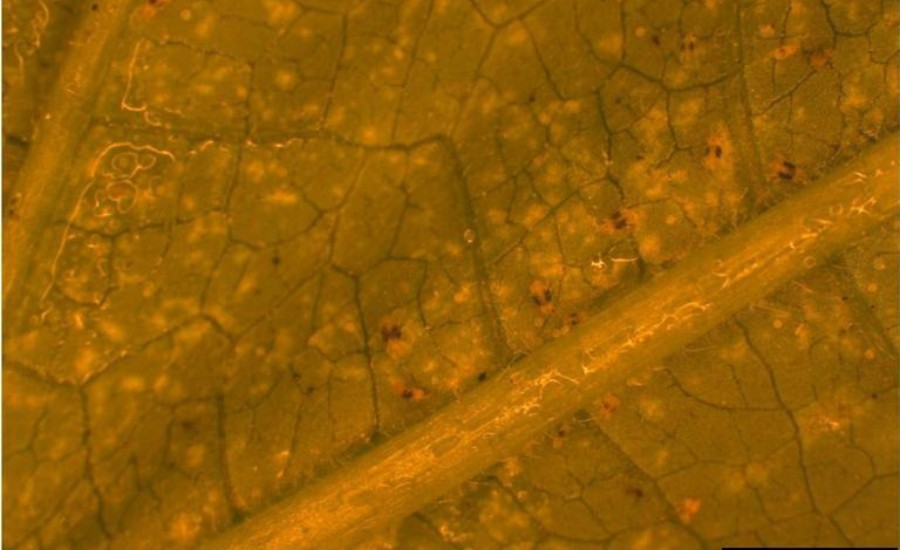
Two-spotted spider mites | Tracy Wootten, University of Delaware, Bugwood.org
6. Spider Mites
While technically not insects, spider mites can cause extensive damage to both evergreen and deciduous trees in Missouri. These tiny arachnids become especially problematic during hot, dry periods, which we often experience during St. Louis summers. They feed by piercing individual plant cells and sucking out the contents, causing a distinctive stippled appearance on leaves.
The first signs of spider mite damage often appear as small yellow or brown speckles on leaves. As feeding continues, leaves may turn completely yellow or bronze, and fine webbing might appear between needles or leaves. Heavily infested trees can lose their leaves prematurely, leading to stress and decline.
The most common type in Missouri is the two-spotted spider mite. Spider mite populations can explode quickly in the right conditions, doubling in just a few days. The easiest way to fight off spider mites is to keep your trees watered, reducing drought stress in the summer.
Basic Tree Care Goes a Long Way in Minimizing Pest Damage
While serious pest management often requires professional intervention, many pest problems can be prevented through proper tree care. The key is keeping trees healthy and minimizing stress, as pests often target already stressed or weakened trees that don’t have enough energy to defend themselves.
Keep your trees healthy by:
- Watering deeply but infrequently during dry spells to encourage deep root growth. Most trees need the equivalent of 1 inch of rain per week during the growing season.
- Applying a 2-to-3-inch layer of organic mulch around trees, keeping it at least 6 inches away from the trunk. This helps retain moisture, regulate soil temperature, and prevent damage and soil compaction.
- Avoiding damaging tree roots or trunks with lawn mowers or string trimmers, as wounds create entry points for pests and diseases.
- Removing dead, dying, or broken branches promptly. When branches break off in storms, they can create large wounds that can become an entry point for pests.
- Scheduling annual inspections with Certified Arborists to catch potential problems early. Professional eyes can spot subtle signs of pest activity or stress that property owners might miss.
- Fertilizing trees only when soil tests indicate a specific nutrient deficiency. Over-fertilizing can actually stress trees and make them more attractive to certain pests.
In urban and suburban environments, trees often need love and care in order to thrive in these challenging conditions. In return, you get to experience their shade and beauty for years, if not decades.
FAQs About Tree Pests in Missouri
What time of year should I be most concerned about tree pests?
While different pests emerge at different times, spring is when most pest activity begins in the St. Louis area. This is also when trees are investing energy in new growth, making early detection and treatment especially important.
If I spot one of these pests, how quickly do I need to act?
Time is essential when dealing with tree pests. Some, like the emerald ash borer, can cause irreversible damage within a single season. Contact a Certified Arborist immediately if you notice any signs of an infestation.
How do I know if a tree can be saved or needs to be removed?
The answer depends on the type of pest, extent of damage, and overall tree health. Generally, if more than 50% of a tree shows damage, or if structural integrity is compromised, removal might be the safest option. But only a visual inspection by an ISA Certified Arborist can adequately make that call.
Defend Your Trees from Pests with Professional Care from Mathias Precision Tree Service
Your trees face many threats – pests are just one of those. Through proper tree care, you can support tree health, minimize stress, and reduce their likelihood of infestation. But if pests do take hold of your tree, there might be a chance to save it with targeted treatments.
For expert pest management and tree care in St. Charles and St. Louis Counties, contact Mathias Precision Tree Service. Our Certified Arborists can identify pest problems early and implement effective treatment plans to protect your valuable trees.
Call us at 314-322-7690 or fill out our online form to request an estimate.
